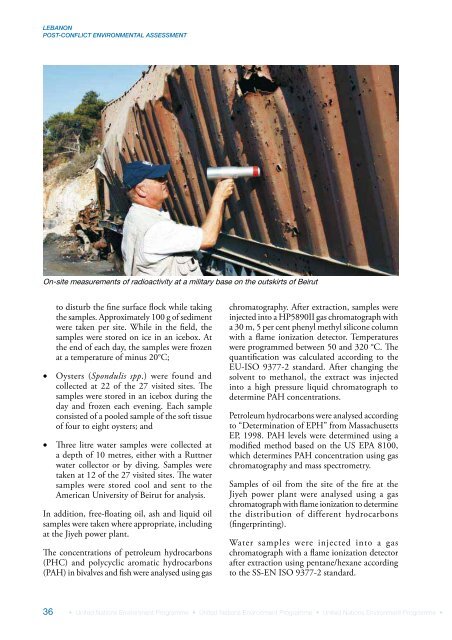Lebanon Post-Conflict Environmental Assessment - UNEP
Lebanon Post-Conflict Environmental Assessment - UNEP
Lebanon Post-Conflict Environmental Assessment - UNEP
Create successful ePaper yourself
Turn your PDF publications into a flip-book with our unique Google optimized e-Paper software.
LEBANONPOST-CONFLICT ENVIRONMENTAL ASSESSMENTOn-site measurements of radioactivity at a military base on the outskirts of Beirutto disturb the fine surface flock while takingthe samples. Approximately 100 g of sedimentwere taken per site. While in the field, thesamples were stored on ice in an icebox. Atthe end of each day, the samples were frozenat a temperature of minus 20°C; Oysters (Spondulis spp.) were found andcollected at 22 of the 27 visited sites. Thesamples were stored in an icebox during theday and frozen each evening. Each sampleconsisted of a pooled sample of the soft tissueof four to eight oysters; and Three litre water samples were collected ata depth of 10 metres, either with a Ruttnerwater collector or by diving. Samples weretaken at 12 of the 27 visited sites. The watersamples were stored cool and sent to theAmerican University of Beirut for analysis.In addition, free-floating oil, ash and liquid oilsamples were taken where appropriate, includingat the Jiyeh power plant.The concentrations of petroleum hydrocarbons(PHC) and polycyclic aromatic hydrocarbons(PAH) in bivalves and fish were analysed using gaschromatography. After extraction, samples wereinjected into a HP5890II gas chromatograph witha 30 m, 5 per cent phenyl methyl silicone columnwith a flame ionization detector. Temperatureswere programmed between 50 and 320 °C. Thequantification was calculated according to theEU-ISO 9377-2 standard. After changing thesolvent to methanol, the extract was injectedinto a high pressure liquid chromatograph todetermine PAH concentrations.Petroleum hydrocarbons were analysed accordingto “Determination of EPH” from MassachusettsEP, 1998. PAH levels were determined using amodified method based on the US EPA 8100,which determines PAH concentration using gaschromatography and mass spectrometry.Samples of oil from the site of the fire at theJiyeh power plant were analysed using a gaschromatograph with flame ionization to determinethe distribution of different hydrocarbons(fingerprinting).Water samples were injected into a gaschromatograph with a flame ionization detectorafter extraction using pentane/hexane accordingto the SS-EN ISO 9377-2 standard.36 • United Nations Environment Programme • United Nations Environment Programme • United Nations Environment Programme •
















